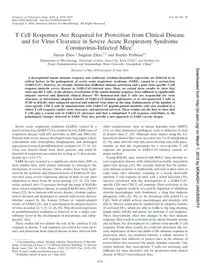
2010 T Cell Responses Are Required for Protection from Clinical Disease and for Virus Clearance in Severe Acute Respirat PDF
Preview 2010 T Cell Responses Are Required for Protection from Clinical Disease and for Virus Clearance in Severe Acute Respirat
JOURNAL OF VIROLOGY, Sept. 2010, p. 9318–9325 Vol. 84, No. 18 0022-538X/10/$12.00 doi:10.1128/JVI.01049-10 Copyright © 2010, American Society for Microbiology. All Rights Reserved. T Cell Responses Are Required for Protection from Clinical Disease and for Virus Clearance in Severe Acute Respiratory Syndrome Coronavirus-Infected Mice� Jincun Zhao,1 Jingxian Zhao,1,2 and Stanley Perlman1* Department of Microbiology, University of Iowa, Iowa City, Iowa 52242,1 and Institute for Tissue Transplantation and Immunology, Jinan University, Guangzhou, China2 Received 14 May 2010/Accepted 25 June 2010 A dysregulated innate immune response and exuberant cytokine/chemokine expression are believed to be critical factors in the pathogenesis of severe acute respiratory syndrome (SARS), caused by a coronavirus (SARS-CoV). However, we recently showed that inefficient immune activation and a poor virus-specific T cell response underlie severe disease in SARS-CoV-infected mice. Here, we extend these results to show that virus-specific T cells, in the absence of activation of the innate immune response, were sufficient to significantly enhance survival and diminish clinical disease. We demonstrated that T cells are responsible for virus clearance, as intravenous adoptive transfer of SARS-CoV-immune splenocytes or in vitro-generated T cells to SCID or BALB/c mice enhanced survival and reduced virus titers in the lung. Enhancement of the number of virus-specific CD8 T cells by immunization with SARS-CoV peptide-pulsed dendritic cells also resulted in a robust T cell response, earlier virus clearance, and increased survival. These studies are the first to show that T cells play a crucial role in SARS-CoV clearance and that a suboptimal T cell response contributes to the pathological changes observed in SARS. They also provide a new approach to SARS vaccine design. Severe acute respiratory syndrome (SARS), caused by a novel coronavirus (SARS-CoV), resulted in over 8,000 cases of respiratory disease, with 10% mortality, in 2002 and 2003 (18). Patients with severe disease developed acute lung injury (ALI), concomitant with neutrophilia, lymphopenia, and prolonged expression of several proinflammatory cytokines (4, 17, 18, 32). Virus was cleared slowly from these patients and could be detected in respiratory secretions for as long as 21 days postin- fection (p.i.) (14, 17). SARS has not recurred to a significant extent since 2003, so most studies have used animal infections to investigate the mechanism of severe disease. These studies have been facili- tated by the isolation and characterization of SARS-CoV vari- ants that cause severe respiratory disease in mice or rats after adaptation to these hosts by serial passage (15, 16, 22). One strain, isolated after 15 passages through the lungs of BALB/c mice, caused respiratory disease in young BALB/c mice (MA15 virus) (22). As in humans with severe disease, cytokine expres- sion is elevated and prolonged in animals with severe disease, whether caused by the human Urbani or rodent-adapted strains of SARS-CoV, and is accompanied by delayed kinetics of virus clearance (1, 5, 15, 23, 26, 35). This elevated expression of proinflammatory mediators is believed to be a major con- tributory factor in the development of pneumonia and, subse- quently, ALI. These studies did not address the role of the antivirus T cell response in disease. T cell responses are critical for virus clear- ance and protection from clinical disease in mice infected with other coronaviruses, such as mouse hepatitis virus (MHV) (31), or other pulmonary pathogens, such as influenza A virus or Sendai virus (7, 29). Although some studies using the Ur- bani strain showed that virus clearance was T cell independent (5, 34), mice infected with this strain develop only mild pneu- monitis, so that the requirement for a virus-specific T cell response for protection in SARS-CoV-infected animals re- mains unclear. Young BALB/c mice infected with MA15 virus develop se- vere respiratory disease, with substantial mortality, dependent upon virus dosage (22). We recently showed that the pulmo- nary immune response is inefficiently activated in these mice at early times after infection, resulting in a barely detectable antivirus T cell response in mice with a lethal infection (35). Survival correlated with the development of a SARS-CoV- specific CD4 and CD8 T cell response. Poor activation of the immune response could be reversed by depletion of inhibitory alveolar macrophages with clodronate, a drug that depletes phagocytic cells (28, 30), or by treatment with poly(I-C) or CpG, both of which activate macrophages and dendritic cells (DCs). Disease could also be ameliorated by adoptive transfer of activated DCs, which are able to traffic to the lung draining lymph nodes (DLN) and prime the antivirus T cell response. These interventions effect two changes in the host immune response: they result in activation of the innate immune system and facilitate the development of a robust virus-specific T cell response. From these results, we could not determine the rel- ative importance of these two limbs of the immune response in protection. Here, we examined whether a robust antivirus T cell response was sufficient to protect mice in the absence of interventions that activated the innate immune response. Our results indicate that virus-specific T cells are necessary and sufficient for virus clearance and for protection from clinical disease in MA15 virus-infected mice. * Corresponding author. Mailing address: Department of Microbi- ology, University of Iowa, 3-712 Bowen Science Building, 51 Newton Road, Iowa City, IA 52242. Phone: (319) 335-8549. Fax: (319) 335- 9999. E-mail:
